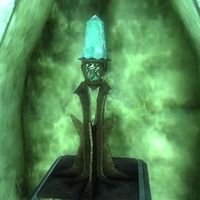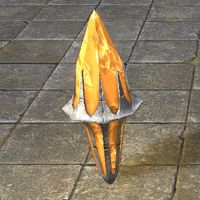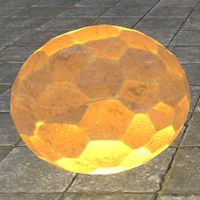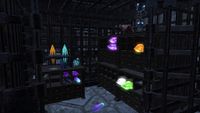Lore:Meteoric Glass
Meteoric Glass (also called Aetherial Crystals)[1] is a variety of Aetherial Fragment. Compared to the more common meteoric iron, it rarely falls to Nirn.[2] The glass is crystalline and comes in various colors. It is prized for being magical in nature and highly enchantable.
The Ayleids, known for harnessing Aetherial Fragments, used the glass to create artifacts like Welkynd Stones and Varla Stones. The crystals were also used as a source of light in Ayleid settlements, likely due to their abhorrence of fire, which they saw as an impure and primal form of light. Skyshards were believed to be shards of Aetherial magicka that carry the essence of Nirn. They are sometimes linked to Lorkhan or Anu.[3][4] Vakka Stones are a type of meteoric glass found in Murkmire[5], while Culanda and Malondo Stones are a variety of meteoric glass used by the Altmer.[6] The Maormer use beads of meteoric glass in their jewelry crafting, harnessing the arcane potential of the glass using an unknown crafting technique.[7]
When properly cultivated, meteoric glass crystals are able to grow and multiply. The Ayleids were only beginning to cultivate the material when they were wiped out by the Alessian Slave Rebellion. Naturally occurring meteoric glass is a common sight in Ayleid ruins, and can often be seen growing on the crumbling limestone walls of these underground structures.[8] Enchanted pieces of meteoric glass, such as Welkynd Stones, can grow in the same way.[9]
Stormhold Crystals and the seven Star Teeth are similar in nature to meteoric glass, but it is unknown if they are made of the material. The origins of the Jewel of Fire also suggest a link to the glass.
Gallery[edit]
References[edit]
- ^ Carac Dena loading screen
- ^ Magic from the Sky — Irlav Jarol
- ^ Soul Shriven in Coldharbour
- ^ Wayshrines of Tamriel — Beredalmo the Signifier
- ^ Vakka Stone quest items
- ^ Aetherial Fragments — Lady Cinnabar of Taneth
- ^ Meteoric Beads Antiquity Codex in ESO
- ^ Events of Oblivion
- ^ Lithnilian's Research Notes — Lithnilian






